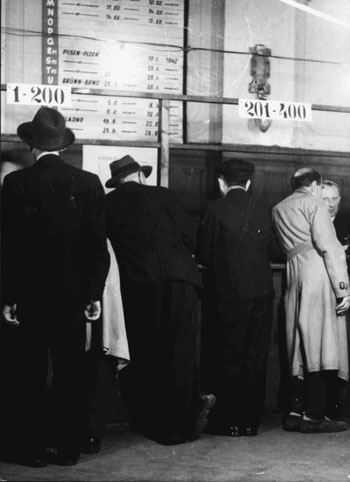The registration of Jews, the seizure of their property and their pauperisation paved the way for their imprisonment between real walls, not just notional ones. The transports of Jews to ghettos and concentration camps commenced the next phase of the final solution to the Jewish question
.
The first deportations took place in October 1939. They were directed to the territory of the Generalgouvernement as part of the plan to create a special Jewish reservation in which Jews from Germany and other parts of the Nazi sphere of power would be concentrated and decimated. Almost 1 300 men from Moravská Ostrava (Mährisch-Ostrau) and Frýdek-Místek (Friedeck-Mistek) were sent in two transports to Nisko nad Sanem, where they were supposed to build a camp themselves. Further transports to Nisko came from Vienna, which was supposed to be cleared of Jews at Hitler's wish. However, the transports were halted, since in the meantime, the Nazi leadership had decided to concentrate the Jewish population in large ghettos. Some of the prisoners were driven out of the camp at Nisko - mostly escaping to Soviet territory - and some of them returned back after the camp was abolished in April 1940.
The systematic deportation of Jews from the territory of the Protectorate started in October 1941 with the transports to the ghetto in Lodz. On the 17th of September, at a meeting with Hitler, the decision was taken to resettle the Jews from the Reich and the Protectorate in the newly-subjugated territories to the east. For the time being, 60 000 Jews were to be concentrated in Lodz. Overcrowding in the ghetto meant that in the end only 20 000 Jews were deported, of which five thousand came from the Protectorate. From January 1942 onward, the overcrowding and problems with food supply in Lodz were dealt with by deportations to nearby Chelmno, where Jews were killed with the use of mobile gas chambers.
Along with the start of deportations to Lodz, a definitive ban was placed on Jews emigrating from the territory of the Reich and the Protectorate. The Centre for Jewish Emigration passed, uninterrupted, into a new kind of activity: the organisation of transports to Lodz, Terezín (Theresienstadt) and other camps. A new registration of Jews was ordered in the Protectorate, and took place from 1st of October 1941 onwards.

Waiting for the transport. (Photograph: Archive of the Jewish Museum in Prague.)
The first of five transports, each one with a thousand people, from Prague to Lodz set out on the 16th of October 1941. The thousand selected Jews had to reach the rallying point several days before the transport left. In a finely worked-out bureaucratic procedure in which the Jews continued to be humiliated, they had all their remaining property sequestered and had to hand over the keys to their flats. They could only take luggage weighing 50 kg per person onto the transports. According to the Nazi interpretation, the deported people lost their rights to the state citizenship they had hitherto had. They became mere inhabitants of the empire of the Nazi concentration camps, an empire of hunger, cold, suffering and gas chambers. Out of the five thousand Czech Jews deported to Lodz only 277 survived.
Lodz and the other ghettos and extermination centres in the east were not yet capable of receiving all the Jews in the Protectorate. It was therefore decided that they should be concentrated on the territory of the Protectorate. The original idea was to set up two ghettos (one for Bohemia, the other for Moravia) close to urban centres with high Jewish populations. In the end, however, the Nazis decided to concentrate the Protectorate Jews in Terezín, which with its fortified character was suitable for the creation of a ghetto, and which could easily be separated from the outside world.
The first transport of 342 young men - the construction commando
- left for Terezín on the 24th of November 1941. They were followed by the great majority of the Protectorate's Jews. By the end of 1942, the majority of the Jewish population had been deported to Terezín from the Protectorate - more than 61 000 men, women and children. In 1943 and 1944 their fate was shared by more than 8 000 Protectorate Jews. At the close of the war - even though it was clear that they were going to be defeated - the Nazis decided to deport Jewish Mischlinge and Jews living in mixed marriages, who had hitherto been protected from deportation. Between the 31st of January and the 16th of March, 3 657 people were deported to Terezín to undertake forced prison labour. From the Sudetenland, which was annexed to the German Reich following the Munich Agreement, over 600 Jews were deported to Terezín from 1942 to 1945. Altogether, more than 74 000 thousand Jews were deported from the Czech lands to the Terezín ghetto
-
Literature
-
Kárný, Miroslav. Terezínská pamětní kniha. Židovské oběti nacistických deportací z Čech a Moravy, 1941-1945. Praha: Nadace Terezínská iniciativa - Melantrich, 1995, vol. I., II. 1559 p.
-
Lagus, Karel, Polák, Josef and Polák, Karel. Město za mřížemi (Stadt hinter Gittern). Praha: Naše vojsko - SPB, 1964. 365 p.
-
Milotová, Jaroslava. Okupační aparát a příprava transporů do Lodže (Die Behörden der Besetzer und Vorbereitung der Transporte nach Lodz). Terezínské studie a dokumenty. in: Terezínské studie a dokumenty (Theresienstädter Studien und Dokumente), 1998, p. 42-66.
-
See also
-
Dokuments: Plan of transports to Terezín from the period of the start of the ghetto until the end of 1942 (in Czech)
-
Dokuments: Transport call-up AE 3 (In Czech)